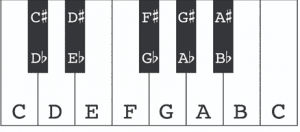Throughout history, plucked instruments have evolved and changed their string amounts and the way they are tuned. The guitar we know and love today evolved from the lutes of the Renaissance and Baroque Era, which had multiple pairs of strings as well as moveable frets made out of cattle gut. It wasn’t until the 1800’s when the Romantic Guitar decided on using only six strings, which allowed the guitarist to play melodic lines and chords more easily.
The Romantic Guitar and Classical Guitar also introduced fixed metal frets which separated the guitar’s notes into easy to find sections. With all the frets on our instruments, it can be intimidating to learn all of the notes that are possible to be played; that is, unless you understand a few basic concepts! Here is an easy way to understand all of the 6 string guitar notes using the musical alphabet and chromatic scale…
Open Strings
First, let’s talk about the 6 open strings of the guitar. Each string has an assigned note and letter name. The order of the open guitar string letters in standard tuning are EADGBE (from the thickest string to the thinnest string). An easy acronym to help you remember this is “Eddy Ate Dynamite Good Bye Eddy”! Some of my younger students also like the acronym “Elephants And Donkeys Grow Big Ears”.
The Musical Alphabet
The names of the letters for guitar strings relate to what we call the “Musical Alphabet Guitar”, which consists of 7 letters; A, B, C, D, E, F, and G. These basic letters are what we call “natural notes”.
However, you may have heard someone mention sharps and flats in music, which are notes that fall between the natural notes. It may help you to think of this like a piano; the white keys are natural notes, and the black keys are the sharps and flats. If I write out the entire musical alphabet in both sharps and flats, it will look like this…
Sharps: A A# B C C# D D# E F F# G G#
Flats: A Bb B C Db D Eb E F Gb G Ab
You might have noticed that there are only 12 notes in the entire musical alphabet. After the 12 notes are played, the alphabet repeats over again. You also may have noticed that there are no sharps or flats between the notes B, C, E, and F. To help you remember this, remember the acronym “Betty Crocker and Elmer Fudd”.
The Chromatic Scale
So, how does all of this actually apply to the guitar? You may be saying to yourself “This seems like another language!”, and you are right! It is the language of music. But stick with me and, with some practice, it will start to make sense.
We are going to use a “chromatic scale” to help you find every note on your guitar. A chromatic scale is where we play every note on our instrument in order without skipping any notes; think of sitting at the piano and playing every white and black key.
Do you remember the 12 notes from the previous section? Each one of those notes corresponds to a fret on the guitar. Let’s take the thickest E string for example. The open string is the note of E, but now we are going to play every fret on that string up to the 12th fret in order. The 12th fret on your guitar will have the same note letter as the open string! If I write out the musical alphabet starting on the open E string with sharps, it will look like this…
E F F# G G# A A# B C C# D D# E
Notice that we use the same letters as before and we have no sharps or flats between E, F, B, and C.
When you are practicing this, I recommend saying the note names out loud as you play them.
This helps your brain connect the notes to what your hands are doing. If you get to the 12th fret and you do not say “E”, you will know that a mistake was made in your chromatic scale. Just go back and try again.
Below is a blank fretboard diagram you can use to test your understanding. Can you fill out the entire chart without looking back at the previous section? Try to fill out every string up to the 12th fret including the sharps and flats. Keep in mind that on the diagram, the top line is your thinnest E string, and the bottom line is your thickest E string.
How do you think you did? Let’s check your answers!
Did you get all of these notes correct? If so, congratulations! You are well on your way to memorizing all the 6 string guitar notes! If you made some mistakes, that’s okay! This takes a little bit of thought when you first learn it, and it takes some memorization if you are completely new to music.
If you made a mistake, go back and try again! Do one string at a time and remember to say the note names out loud. It may help you to start by putting EADGBE into the 12th fret before restarting the chart.
This Concept is Critical to Learning Guitar
This may seem like a lot at first, but this concept is crucial to understanding the layout of your instrument. Start by only looking at the musical alphabet written out, and then see if you can count up while playing every fret on a string of your choice. Keep practicing! You will get it! In no time you will know all of the strings on a guitar notes.
Need extra help learning the 6 string guitar notes? Here is a free 22 minute video I made for my former high school guitar students on this topic. Feel free to follow along with me as I show you how to play the chromatic scale using three different methods.
Zach Deyo





